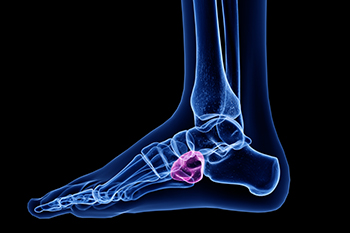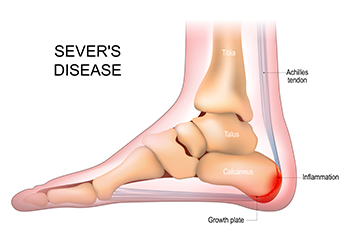Connect With Us
Blog
Items filtered by date: July 2025
Reminder: When Was the Last Time...?
Relieving Foot Pain from Cuboid Syndrome

Cuboid syndrome is a condition where the cuboid bone in the foot becomes misaligned, often causing sharp pain along the outer side of the foot. It can result from overuse, ankle sprains, or repetitive stress from activities like running or jumping. Risk factors include wearing improper footwear, flat feet, or uneven gait patterns. Symptoms may include localized pain, weakness, and difficulty bearing weight. The cuboid whip is a manual technique used to realign the bone quickly and effectively, often providing immediate relief. A podiatrist can diagnose cuboid syndrome through a physical examination and provide treatments such as manipulation, orthotics, and rehabilitation. If you are experiencing foot pain, it is suggested that you consult a podiatrist who can provide an accurate diagnosis and treatment.
Cuboid syndrome, also known as cuboid subluxation, occurs when the joints and ligaments near the cuboid bone in the foot become torn. If you have cuboid syndrome, consult with Raul Hidalgo DPM from South Texas Foot & Ankle Care. Our doctor will assess your condition and provide you with quality foot and ankle treatment.
Cuboid syndrome is a common cause of lateral foot pain, which is pain on the outside of the foot. The condition may happen suddenly due to an ankle sprain, or it may develop slowly overtime from repetitive tension through the bone and surrounding structures.
Causes
The most common causes of cuboid syndrome include:
- Injury – The most common cause of this ailment is an ankle sprain.
- Repetitive Strain – Tension placed through the peroneus longus muscle from repetitive activities such as jumping and running may cause excessive traction on the bone causing it to sublux.
- Altered Foot Biomechanics – Most people suffering from cuboid subluxation have flat feet.
Symptoms
A common symptom of cuboid syndrome is pain along the outside of the foot which can be felt in the ankle and toes. This pain may create walking difficulties and may cause those with the condition to walk with a limp.
Diagnosis
Diagnosis of cuboid syndrome is often difficult, and it is often misdiagnosed. X-rays, MRIs and CT scans often fail to properly show the cuboid subluxation. Although there isn’t a specific test used to diagnose cuboid syndrome, your podiatrist will usually check if pain is felt while pressing firmly on the cuboid bone of your foot.
Treatment
Just as the range of causes varies widely, so do treatments. Some more common treatments are ice therapy, rest, exercise, taping, and orthotics.
If you have any questions, please feel free to contact our office located in San Antonio, TX . We offer the newest diagnostic and treatment technologies for all your foot care needs.
Arthritis Can Cause Pain in the Feet and Ankles
What Your Foot May Be Telling You About Morton’s Neuroma

Morton’s neuroma is a nerve issue that most often develops between the third and fourth toes. It can feel like a small pebble is stuck in your shoe or a burning or tingling sensation in the ball of the foot. Some people notice numbness that comes and goes, especially when wearing tight shoes or walking for long periods of time. The pain may improve when shoes are removed or the foot is rubbed, but the symptoms often return. Over time, the discomfort can become more frequent or intense. Without treatment, daily activities may become difficult. Because Morton’s neuroma involves a thickened nerve, early care can help avoid further irritation. If you are noticing strange sensations or pain in your forefoot, it is suggested that you see a podiatrist for a thorough exam and a clear plan for relief.
Morton’s neuroma is a very uncomfortable condition to live with. If you think you have Morton’s neuroma, contact Raul Hidalgo DPM of South Texas Foot & Ankle Care. Our doctor will attend to all of your foot care needs and answer any of your related questions.
Morton’s Neuroma
Morton's neuroma is a painful foot condition that commonly affects the areas between the second and third or third and fourth toe, although other areas of the foot are also susceptible. Morton’s neuroma is caused by an inflamed nerve in the foot that is being squeezed and aggravated by surrounding bones.
What Increases the Chances of Having Morton’s Neuroma?
- Ill-fitting high heels or shoes that add pressure to the toe or foot
- Jogging, running or any sport that involves constant impact to the foot
- Flat feet, bunions, and any other foot deformities
Morton’s neuroma is a very treatable condition. Orthotics and shoe inserts can often be used to alleviate the pain on the forefront of the feet. In more severe cases, corticosteroids can also be prescribed. In order to figure out the best treatment for your neuroma, it’s recommended to seek the care of a podiatrist who can diagnose your condition and provide different treatment options.
If you have any questions, please feel free to contact our office located in San Antonio, TX . We offer the newest diagnostic and treatment technologies for all your foot care needs.
Gout Pain Can Be Managed
Sever's Disease in Growing Children

Sever's disease, also known as calcaneal apophysitis, is a common cause of heel pain in growing children. It occurs when the growth plate in the heel becomes inflamed due to repetitive stress or pressure. This condition often affects active children between 8 and 14 years old who are involved in sports that include running or jumping. Risk factors include rapid growth, flat feet, poor footwear, and intense physical activity. Symptoms may include heel pain, limping, stiffness, and tenderness in the back of the foot. A podiatrist can diagnose Sever's disease through a physical exam and recommend treatments, such as rest, stretching, proper footwear, and custom inserts. If your active child has heel pain, it is suggested that you visit a podiatrist for an accurate diagnosis and treatment plan.
Sever's disease often occurs in children and teens. If your child is experiencing foot or ankle pain, see Raul Hidalgo DPM from South Texas Foot & Ankle Care. Our doctor can treat your child’s foot and ankle needs.
Sever’s Disease
Sever’s disease is also known as calcaneal apophysitis, which is a medical condition that causes heel pain I none or both feet. The disease is known to affect children between the ages of 8 and 14.
Sever’s disease occurs when part of the child’s heel known as the growth plate (calcaneal epiphysis) is attached to the Achilles tendon. This area can suffer injury when the muscles and tendons of the growing foot do not keep pace with bone growth. Therefore, the constant pain which one experiences at the back of the heel will make the child unable to put any weight on the heel. The child is then forced to walk on their toes.
Symptoms
Acute pain – Pain associated with Sever’s disease is usually felt in the heel when the child engages in physical activity such as walking, jumping and or running.
Highly active – Children who are very active are among the most susceptible in experiencing Sever’s disease, because of the stress and tension placed on their feet.
If you have any questions, please feel free to contact our office located in San Antonio, TX . We offer the newest diagnostic and treatment technologies for all your foot care needs.
Are Bunions Affecting Your Everyday Life?
Diabetic Foot Problems

Diabetic foot problems can affect one or both feet and can occur in people with type 1 or type 2 diabetes. High blood sugar levels can damage nerves and reduce blood flow, making feet more vulnerable to injuries, infections, and ulcers. Symptoms include numbness, tingling, burning sensations, dry or cracked skin, swelling, and slow-healing wounds. Feet may appear discolored, swollen, or develop sores that do not heal. Due to nerve damage, pain may be minimal even with serious injuries. A podiatrist can diagnose diabetic foot issues with thorough foot exams, assessing circulation and sensation. Treatment focuses on preventing complications with regular foot care, custom orthotics, wound management, and patient education on hygiene and footwear. If you are dealing with this condition, it is suggested that you make an appointment with a podiatrist for evaluation and treatment.
Diabetic foot care is important in preventing foot ailments such as ulcers. If you are suffering from diabetes or have any other concerns about your feet, contact Raul Hidalgo DPM from South Texas Foot & Ankle Care. Our doctor can provide the care you need to keep you pain-free and on your feet.
Diabetic Foot Care
Diabetes affects millions of people every year. The condition can damage blood vessels in many parts of the body, especially the feet. Because of this, taking care of your feet is essential if you have diabetes, and having a podiatrist help monitor your foot health is highly recommended.
The Importance of Caring for Your Feet
- Routinely inspect your feet for bruises or sores.
- Wear socks that fit your feet comfortably.
- Wear comfortable shoes that provide adequate support.
Patients with diabetes should have their doctor monitor their blood levels, as blood sugar levels play such a huge role in diabetic care. Monitoring these levels on a regular basis is highly advised.
It is always best to inform your healthcare professional of any concerns you may have regarding your feet, especially for diabetic patients. Early treatment and routine foot examinations are keys to maintaining proper health, especially because severe complications can arise if proper treatment is not applied.
If you have any questions, please feel free to contact our office located in San Antonio, TX . We offer the newest diagnostic and treatment technologies for all your foot care needs.
Are You Suffering From Ingrown Toenails?
Relief From Ingrown Toenails Through Surgery

An ingrown toenail occurs when the edge of the nail grows into the surrounding skin, leading to pain, swelling, and sometimes infection. When conservative care does not resolve the issue, surgical procedures called a partial or total nail avulsion may be performed. In this procedure, the podiatrist numbs the toe, removes the offending portion of the nail, and may apply a solution to prevent it from growing back. This treatment offers lasting relief and promotes proper healing. If you struggle with recurring ingrown toenails, it is suggested that you consult a podiatrist for an expert evaluation and a permanent solution to restore comfort and function.
Foot surgery is sometimes necessary to treat a foot ailment. To learn more, contact Raul Hidalgo DPM of South Texas Foot & Ankle Care. Our doctor will assist you with all of your foot and ankle needs.
When Is Surgery Necessary?
Foot and ankle surgery is generally reserved for cases in which less invasive, conservative procedures have failed to alleviate the problem. Some of the cases in which surgery may be necessary include:
- Removing foot deformities like bunions and bone spurs
- Severe arthritis that has caused bone issues
- Cosmetic reconstruction
What Types of Surgery Are There?
The type of surgery you receive will depend on the nature of the problem you have. Some of the possible surgeries include:
- Bunionectomy for painful bunions
- Surgical fusion for realignment of bones
- Neuropathy decompression surgery to treat nerve damage
Benefits of Surgery
Although surgery is usually a last resort, it can provide more complete pain relief compared to non-surgical methods and may allow you to finally resume full activity.
Surgical techniques have also become increasingly sophisticated. Techniques like endoscopic surgery allow for smaller incisions and faster recovery times.
If you have any questions, please feel free to contact our office located in San Antonio, TX . We offer the newest diagnostic and treatment technologies for all your foot care needs.
Blog Archives
- August 2025
- July 2025
- June 2025
- May 2025
- April 2025
- March 2025
- February 2025
- January 2025
- December 2024
- November 2024
- October 2024
- September 2024
- August 2024
- July 2024
- June 2024
- May 2024
- April 2024
- March 2024
- February 2024
- January 2024
- December 2023
- November 2023
- October 2023
- April 2022
- March 2022
- February 2022
- January 2022
- December 2021
- November 2021
- October 2021
- September 2021
- August 2021
- July 2021
- June 2021
- May 2021
- April 2021
- March 2021
- December 2018
- November 2018
- October 2018
- September 2018
- August 2018
- July 2018
- June 2018
- May 2018
- April 2018
- March 2018
- February 2018
- January 2018
- December 2017
- November 2017
- October 2017





